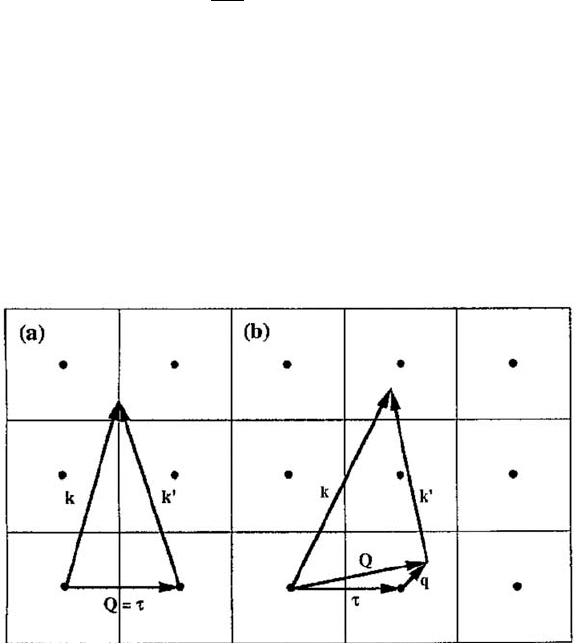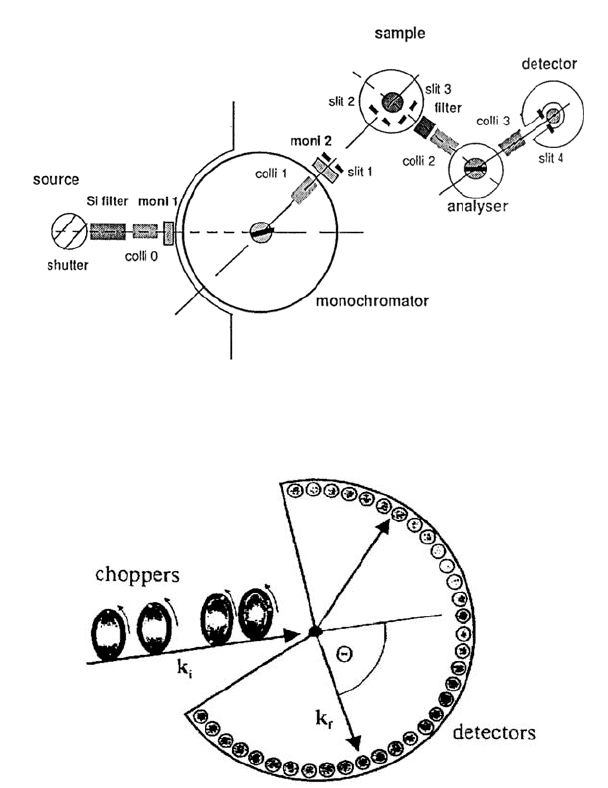Vij D.R. Handbook of Applied Solid State Spectroscopy
Подождите немного. Документ загружается.


6.2 The Crystal Field Interaction
adjustable parameters. For low symmetry sites such as orthorhombic
symmetry with nine independent crystal field parameters (see equation (6.12)),
it is a highly nontrivial task in the least squares fitting procedure to the
experimental data to find a correct set of starting parameters. However, we
can make use of the fact that the crystal field parameters
B
n
m
for a particular
degree n can reasonably be determined by taking account of the geometry of
the nearest neighboring coordination polyhedra (see equation (6.18)):
00
BB /
mm
nnnn
ff (6.30)
i.e., we are left with only three independent crystal field parameters
B
n
0
(n = 2, 4, 6). Following [12] we introduce a parameterization which covers all
possible ratios of
B
2
0
/B
4
0
and B
2
0
/B
6
0
:
0
22
0
44
0
66
BF (1 | |)
BF
BF (1 | |)
Wy
Wxy
Wxy
(6.31)
with –1 x, y 1. Equation (6.31) corresponds to the most general
combination of second-, fourth- and sixth-order diagonal crystal field
parameters. Usually only one set of x, y parameters gives a reasonable
agreement with the spectroscopic data, thus we have solved the problem of
assigning the leading diagonal start parameters of the least squares fitting
procedure in a reasonable manner. In a second step, we can then try to achieve
a fine-tuning of the remaining nondiagonal crystal field parameters.
An alternative way to derive a starting set of crystal field parameters is to
consider the extended point-charge model (see Section 6.2.2.2), provided that
the nearest-neighbor point charges, as well as the screening length (in metallic
systems), are known.
6.2.4 Extrapolation Schemes
In many models the structure and charge aspects of the crystal field
interaction can be separated as exemplified for the point-charge model by
equation (6.18) and for the superposition model by equation (6.25). This
offers a convenient extrapolation scheme for the crystal field potential along a
series of rare earth compounds provided that the charge distribution of the
coordinating ligand ions is not affected by the particular rare earth ions. The
procedure for extrapolating the crystal field parameters from one compound
(R
1
) to another compound (R
2
) based on equation (6.18) yields:
2
21
1
(R )
B(R) B(R)
(R )
nm
nn
mm
nn
nm
nn
rf
rf
FÃ Ó
FÃ Ó
.
(6.32)
267

6. Crystal Field Spectroscopy
respectively; see Section 4.1 for Cs
2
NaRBr
6
.
6.2.5 Calculation of Thermodynamic Magnetic Properties
In order to check the reliability of the crystal field parameters it is
important
to calculate various thermodynamic magnetic properties and
to compare the
results
with experimental data. These properties depend
explicitly upon both
the
crystal field energies E
i
and the crystal field
wavefunctions |*
i
Ó .
Based
on general expressions of statistical
mechanics for the Gibbs free energy
F = – k
B
T ln Z and the internal
energyU = F–T(wF/wT )
V
, where Z is
function, we obtain
for the magnetization:
B
B
1(ln)
M|J|,
H
ii i
i
Z
gp
kT
DD
D
P**
Ç
(6.33)
for the single-ion susceptibility:
2
2
2
B
B
||J||
M||J||
() ( ),
H
ji
ii
iji
iij
ij
gppp
kT E E
D
DD
DD
D
ÌÜ
Ã* * Ó
Ã**Ó
F P
ÌÜ
ÌÜ
ÍÝ
ÇÇ
(6.34)
and for the Schottky heat capacity:
22
vB
V
BB
,
ii
ii
ii
EE
U
ck pp
TkTkT
ËÛ
ÈØ È Ø
ÈØ
ÌÜ
ÉÙ
ÉÙ É Ù
ÊÚ
ÊÚ Ê Ú
ÌÜ
ÍÝ
ÇÇ
(6.35)
with the Boltzmann population factor
B
1
exp .
i
i
E
p
Z
kT
ÎÞ
Ïß
Ðà
(6.36)
6.3 EXPERIMENTAL TECHNIQUES
6.3.1 Introductory Remarks
The crystal field interaction discussed in the preceding section gives rise to
discrete energy levels E
i
and wavefunctions |
i
T Ó which can be determined by
a variety of experimental methods. The most powerful techniques are
certainly spectroscopic methods such as inelastic neutron scattering, light
scattering, and point-contact spectroscopy, which allow a direct determination
of the crystal field states. Light scattering offers several methods working
This procedure was successfully applied to a large number of both insulating
and metallic rare earth (R) compounds, e.g., for Cs
2
NaRBr
6
[25] and for RPd
3
[26],
268
the parti-
tion
6.3 Experimental Techniques
with different modes of operation at different wavelengths, e.g., Raman,
infrared, photoemission, X-ray absorption, and luminescence spectroscopy.
Some information about the crystal field states can also be obtained by
resonance techniques, e.g., in a paramagnetic resonance experiment one is
measuring the Zeeman splitting of a given ground state crystal field level,
which has seen extensive applications in rare earth salts [1]. Sometimes it is
possible to use the Mössbauer effect to observe a zero-field magnetic
hyperfine splitting associated with the rare earth ions yielding valuable
information about the crystal field parameter
B
2
0
[27], which is difficult to
determine by model calculations due to the long-range nature of the 2
nd
order
crystal field potential. Information on the crystal field states is also contained
intrinsically in the thermodynamic magnetic properties (see equations (6.33)–
(6.36)); however, an extraction of crystal field parameters is likely to fail (as
demonstrated in Section 6.4.1) due to the integral nature of these properties.
In this work we will describe only a few spectroscopic techniques that have
been applied to the study of crystal field effects. These include primarily
inelastic neutron scattering and to a lesser extent Raman scattering and point-
contact spectroscopy. Both inelastic neutron and Raman scattering
experiments have their merits and should be considered as complementary
methods. Raman scattering, on the one hand, can be applied to very small
samples of the order of 10 Pm
3
; it provides highly resolved spectra so that
small line shifts and splittings can be detected [28], and it covers a large
energy range so that intermultiplet transitions can easily be observed [29].
Neutron scattering, on the other hand, is not restricted to particular points in
reciprocal space, i.e., interactions between the rare earth ions can be observed
through the wavevector dependence [30], the intensities of crystal field
transitions can easily be interpreted on the basis of the wavefunctions of the
crystal field states, and data can be taken over a wide temperature range,
which is important when studying linewidths of crystal field transitions.
Inelastic neutron scattering as the most widely used spectroscopic technique is
described below in detail, followed by short descriptions of Raman and point-
contact spectroscopy.
6.3.2 Neutron Spectroscopy
The principal aim of a neutron scattering experiment is the determination of
the probability that a neutron incident on the sample with wavevector k is
scattered into the state with wavevector
k
'. The intensity of the scattered
neutrons is thus measured as a function of the momentum transfer
(),==
'
Q= k k
(6.37)
where Q is known as the scattering vector, and the corresponding energy
transfer is given by
269

6. Crystal Field Spectroscopy
2
2'2
().
2
kk
m
Z
=
=
(6.38)
Equations (6.37) and (6.38) describe the momentum and energy conservation
of the neutron scattering process, respectively. The momentum conservation
is schematically sketchedin Figure 6.2. For k =
k
' we have fromequation (6.38)
0 Z=
, i.e., elastic scattering. Figure 6.2a shows the particular situation
Q = k–k' =
W, which is just the condition known as Bragg’s law. Inelastic
scattering is visualized in Figure 6.2b where the scattering vector can be
decomposed according to Q =
W+ q, with q being the wavevector of an
elementary excitation to be specified. Neutron scattering turns out to be the
only experimental technique that is able to measure the dispersion relation
Z(q)
at any predetermined point in reciprocal space.
Figure 6.2 Visualization of equation (6.37) in reciprocal space for elastic (a) and inelastic (b)
neutron scattering. The lines indicate the boundaries of the Brillouin zone, and the full circles
denote the zone centers.
controlled access to the variables Q and Z. This can be done in various ways,
but by far the most effective experimental method is the triple-axis crystal
spectrometry developed by Brockhouse [31] who received the 1994 physics
Nobel Prize for this achievement. The principle of this method is sketched in
Figure 6.3. An incident beam of neutrons with a well-defined wavevector k is
selected from the white spectrum of the neutron source by the monochromator
crystal and scattered from the sample. The intensity of the scattered beam is
measured as a function of
k
' by the analyzer crystal and the neutron detector.
The outstanding advantage of the triple-axis spectrometer is that data can
be taken at predetermined points in reciprocal space (which is known as the
“constant-Q” or “constant-Z” method), so that single-crystal measurements of
course, general scans in Q and Z are also possible.
=
The determination of Z(q) by neutron scattering techniques requires a
the dispersion relation
Z(Q) can be performed in a controlled manner. Of
=
=
270

Figure 6.3 Basic layout of a triple-axis spectrometer. The three axes around which the
respective rest of the spectrometer is rotated are: the monochromator axis (variation of k), the
Figure 6.4 Schematic of a direct time-of-flight spectrometer. The four choppers define the
energy and the pulse width of the incident neutrons. In addition, they suppress higher order
neutrons and frame overlap.
For neutron scattering experiments on polycrystalline, liquid, and
amorphous materials, various types of time-of-flight spectrometers are usually
more appropriate. In the time-of-flight method the neutron beam is
monochromatized by a series of choppers that produce pulses of neutrons with
the desired wavelength and that eliminate higher order neutrons and frame
overlap of pulses from different repetition periods as well (see Figure 6.4).
The monochromatic neutron pulses are then scattered from the sample and are
detected by arrays of neutron counters covering a large solid angle. The
energy transfer
Z= and the modulus of the scattering vector Q are then
determined by the flight time of the neutrons from the sample to the detector
and by the scattering angle at which the detector is positioned, respectively.
sample axis (variation of the scattering angle), and the analyzer axis (variation of k').
6.3 Experimental Techniques
271

6. Crystal Field Spectroscopy
The neutron scattering cross-section corresponds to the number of neutrons
scattered persecondintoa(small) solid angle d: with energy transfers between
Z= and ()dZZ= , divided by the flux of the incident neutrons. Theoretical
expressions for the cross-section usually start from Fermi’s “golden rule”:
2
2
2
'
2
'
ˆ
|','|U |k, | ( ).
2
dm
pk EE
dd k
OOO
OO
V
ÈØ
ÃOOÓGZ
ÉÙ
ÊÚ
:Z S
ÇÇ
=
=
(6.39)
Here,
| OÓ denotes the initial state of the scatterer, with energy E
O
and thermal
population factor
P
O
, and its final state is |'O Ó .
ˆ
U
is the interaction operator
of the neutron with the sample, which depends on the specific scattering
process. For magnetic scattering the interaction operator Û
m
of the neutron
with the sample may be described by the interaction of a neutron with a
magnetic field H:
N
ˆ
ˆˆ
U
m
JP V ¹ ¹H,P +
(6.40)
where
ˆ
the
gyromagnetic ratio,
N
P
= 0.505·10
–19
erg·T
–1
the nuclear magneton, and
V
ˆ
a
Pauli spin operator. For a large class of magnetic compounds
the magnetic
field
H
used in equation (6.40) is generated by unpaired
electrons. The
magnetic field due to a single electron moving with
velocity
v
e
is given
by:
33
curl ,
ee
e
c
ÎÞ
S
Ïß
Ðà
RvR
H=
|R| |R|
(6.41)
where R is the distance from the electron to the point at which the field is
measured, e = 1.602·10
–19
C the elementary charge, and c = 3·10
10
cm·s
–1
the
velocity of light. The magnetic moment operator of an electron is
ˆ
ˆ
2,
B
PP s
(6.42)
where
P
B
ҏ
= 0.927·10
–16
erg·T
–1
is the Bohr magneton and
s
ˆ
the spin
operator
of the electron. The first term of equation (6.41) arises from
the spin of
the
electron, and the second from its orbital motion.
The major task in the evaluation of the magnetic neutron cross-section is
the calculation of the transition matrix element in equation (6.39). This was
first done by Halpern and Johnson [32], and more recently in many excellent
text books on neutron scattering [33, 34]. For unpolarized neutrons, identical
magnetic ions with localized electrons, and spin-only scattering the following
“master formula” is obtained:
2
22
o
2
,
QQ
'
() ()exp{2()} S(,),
Q
dk
rF W
dd k
DE
DE
DE
DE
JGZ
:Z
ÈØ
ÉÙ
ÊÚ
Ç
QQ Q
(6.43a)
where S
DE
(Q, Z) is the magnetic scattering function:
ij i
j
,,
'
ˆˆ
S(, )= exp{ ( )} |S|' '|S|
().
ij
ip
EE
E
DE D
O
OO
OO
ZOOOO
GZ
¹
¹
ÇÇ
=
QQRR
(6.43b)
k
P
is the magnetic moment operator of the neutron, J = –1.91
'
e
V
272

6.3 Experimental Techniques
r
0
= 0.282·10
–12
cm is the classical electron radius, F(Q) the dimensionless
magnetic form factor defined as the Fourier transform of the normalized spin
density associated with the magnetic ions, exp{–2W(Q)} the Debye-Waller
factor, and
ˆ
S
i
D
(D = x,y,z) the spin operator of the ith ion at site R
i
. From the
magnitude of r
0
we expect the magnetic neutron cross-section to be of the
order 10
–24
cm
–2
.
The essential factor in equation (6.43) is the magnetic scattering function
S
DE
(Q,Z) which will be discussed in more detail below. There are two further
factors that govern the cross-section for magnetic neutron scattering in a
characteristic way: First, the magnetic form factor F(Q) which usually falls
off with increasing modulus of the scattering vector Q. Second, the
polarization factor (G
DE
–Q
D
Q
E
/Q
2
) tells us that neutrons can only couple to
magnetic moments or spin fluctuations perpendicular to Q, which un-
ambiguously allows us to determine moment directions or to distinguish
between different polarizations of spin fluctuations.
Equation (6.43) strictly applies to cases where the orbital angular
momentum of the magnetic ions is either zero or quenched by the crystal field.
A theoretical treatment of the scattering by ions with unquenched orbital
moment was given by Johnston [35], however, the calculation is complicated,
and we simply quote the result for Qo0. In this case the cross-section
measures the magnetization,
P = –P
B
(L + 2S), i.e., a combination of spin and
orbital moments that does not allow their separation. This clearly contrasts to
magnetic scattering by X-rays. For magnetic neutron scattering an
approximate result can be obtained for modest values of Q. We replace the
spin operator
Į
ˆ
S
i
in equation (6.43) by:
1
ĮĮ
2
ˆ
ˆ
SJ
=
ii
g
,
(6.44)
where
J(J + 1)
-
L(L + 1) + S(S + 1)
1+
2J(J + 1)
g
(6.45)
is the Landé splitting factor and
D
i
J
ˆ
is an effective angular momentum
operator (e.g., for rare earth ions J is the total angular momentum quantum
number resulting from the spin-orbit coupling which combines the spin and
orbital angular momentum L and S, respectively).
If Z is a positive quantity in the scattering function S
DE
(Q,Z) of equation
(6.43), the neutron loses energy in the scattering process and the system is
excited from the initial state
| O which has energy
Z=
less than the final state
|'O . Consider now the function S
DE
(Q,–Z) where Zҏ is the same positive
quantity. This represents a process in which the neutron gains energy. The
transitions of the system are between the same states as for the previous
process, but now
|'O is the initial state and | O is the final state. The
probability of the system being initially in the higher state is lower by the
273

6. Crystal Field Spectroscopy
factor
B
exp{-hȦ/
}
kT than its probability of being in the lower energy state,
hence
Įȕ Įȕ
B
S(, ) exp S(,) ,
kT
½
Z
Z Z
®¾
¯¿
=
QQ
(6.46)
which is known as the principle of detailed balance. Equation (6.46) must be
applied in the analysis of experimental data taken in both energy-gain and
energy-loss configurations which correspond to the so-called Stokes and anti-
Stokes processes, respectively.
Using the integral representation of the G-function,
^`
'
'
()
1
()exp exp,
2
EEt
EE i itdt
OO
OO
GZ Z
S
ÎÞ
Ïß
Ðà
Ô
=
==
(6.47)
the scattering function S
DE
(Q,Z) (equation (6.43)) transforms into a physically
transparent form:
^`
^`
j
,
1
ˆˆ
S(,) exp ( )S(0)S()exp .
2
iji
ij
ititdt
E
DE D
ZZ
S
¹
Ç
Ô
=
QQRR
(6.48)
S(0)S()
ij
t
DE
is the thermal average of the time-dependent spin operators. It
corresponds to the van Hove pair correlation function [36] and gives
essentially the probability that, if the magnetic moment of the ith ion at site R
i
has some specified (vector) value at time zero, then the moment of the jth ion
at site R
j
has some other specified value at time t. A neutron scattering
experiment measures the Fourier transform of the pair correlation function in
space and time, which is clearly just what is needed to describe a magnetic
system on an atomic scale.
The van Hove representation of the cross-section in terms of pair
correlation functions is related to the fluctuation-dissipation theorem [33, 34]:
1
B
S(,) 1exp Im (,),
N
kT
DE DE
Z
ZFZ
S
ÈØ
ÎÞ
Ïß
ÉÙ
ÊÚ
Ðà
==
QQ
(6.49)
where N is the total number of magnetic ions. Physically speaking, the
neutron may be considered a magnetic probe, which effectively establishes a
frequency- and wavevector-dependent magnetic field H
E
(Q,Z) in the
scattering sample, and detects its response, M
D
(Q,Z), to this field by
M
D
Q,Z
F
DE
Q,Z
H
E
Q,Z
,
(6.50)
where F
DE
(Q,Z) is the generalized magnetic susceptibility tensor. This is
really the outstanding property of the neutron in a magnetic scattering
measurement, and no other experimental technique is able to provide such
detailed microscopic information about magnetic compounds.
If the coupling between the magnetic ions is weak, we are left with a
single-ion problem, thus the excitation energies will be independent of the
scattering vector Q. Typical examples are rare earth compounds that exhibit
274

6.3 Experimental Techniques
dominant mechanism is the crystal field interaction.
The effect of the crystal field on a rare earth ion is to partially or totally
remove the (2J + 1)-fold degeneracy of the ground state J-multiplet. This is
exemplified at the top of Figure 6.5 for Pr
3+
ions in the hexagonal compound
PrBr
3
[37]. The crystal field levels resulting from the Hamiltonian (11) are
denoted by the irreducible representations *
n
, and the corresponding wave-
functions are:
J
M=
-
j
|(M)|M.
nn
a*
Ç
(6.51)
From the sequence of the energy levels, properly identified by their
irreducible representations *
n
, the crystal field potential can be
unambiguously determined.
In evaluating the cross-section for the crystal field transition *
n
o*
m
we
start from the scattering law S
DE
(Q,Z) defined by equation (6.43). Since we
are dealing with single-ion excitations, we have i = j, so that the Q-
dependence vanishes. For N identical magnetic ions we can even drop the
index i. S
DE
(Q,Z) then reduces to:
where N is the total number of magnetic ions and
n
p
*
the Boltzmann
population factor. From the symmetry relations associated with the matrix
elements we find the cross-section
^`
2
2
2
o
2
2
1'
()exp 2 ()
2
ˆ
1|||| .
n
nm
mn
dk
Ngr F W p
dd k
EE
*
D
D
**
D
V
J
:Z
**GZ
ÈØ
ÉÙ
ÊÚ
ÈØ
ÉÙ
ÊÚ
Ç
=
2
QQ
Q
J
Q
(6.53)
The polarization factor permits discrimination between transverse (D= x,y)
and longitudinal (D = z) crystal field transitions by measuring at different Q.
This is nicely demonstrated in Figure 6.5. For Q||c only transverse transitions
are observed, whereas for QAc the transverse transitions lose half their
intensities, and in addition longitudinal transitions appear. The lines in
Figure 6.5 were calculated without any disposable parameters, i.e., the
intensities of the crystal field transitions are excellently described by equation
(6.53).
For experiments on polycrystalline material, equation (6.53) has to be
averaged in Q space:
^`
2
2
22
o
1'
ˆ
()exp 2 () | | | |
2
,
n
nm
mn
dk
Ngr F W p
dd k
EE
*
**
Z
J**
:Z
GZ
A
ÈØ
ÉÙ
ÊÚ
=
QQ J
(6.54)
very low magnetic-ordering temperatures or do not order at all. In this case the
ˆˆ
S() J J ,
n nm
nmmn
Np E E
αβ α β
ΓΓΓ
ωΓΓΓΓδω=
||
|
|
(6.52)
275

6. Crystal Field Spectroscopy
where J
A
= J–(J·Q)Q/Q
2
is the component of the total angular momentum
perpendicular to the scattering vector Q, and
22
2
ˆˆ
|||| ||||.
3
mn mn
D
D
** **
A
Ç
JJ
(6.55)
These matrix elements have been tabulated by Birgeneau [38] for cubic
crystal fields.
Figure 6.5 Energy spectra of neutrons scattered from single-crystalline PrBr
3
at T=1.5 K for Q
parallel and perpendicular to the c-axis. The resulting crystal field level scheme and the
observed transverse (t) and longitudinal (l) ground state transitions are indicated at the top (after
[37]).
6.3.3 Raman Spectroscopy
Raman spectroscopy utilizes light scattering to gain information about
elementary excitations of matter such as phonons, magnons, and electronic
single particle or collective excitations within a sample (for a review and
references see, e.g., [39]). When a photon (usually produced from a laser in
the visible, near infrared, or near ultraviolet range) interacts with a solid it can
scattering); ii) inelastically scattered by quasi-particle excitations (Raman
process), thereby either giving energy to the medium (Stokes scattering) or
removing energy from it (anti-Stokes scattering). A Raman process arises
be: i) elastically scattered and thus retain its incident energy (Rayleigh
276
